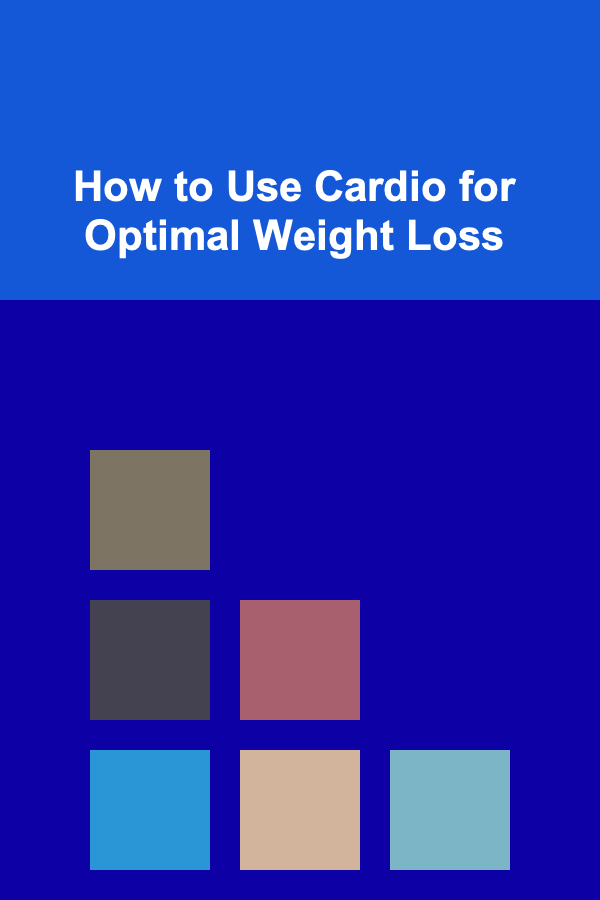
How to Use Cardio for Optimal Weight Loss
ebook include PDF & Audio bundle (Micro Guide)
$12.99$6.99
Limited Time Offer! Order within the next:

Cardiovascular exercise, or cardio, is a fundamental component of a healthy lifestyle, especially for those aiming to lose weight. Whether you are new to fitness or an experienced athlete, understanding how to effectively use cardio for optimal weight loss can help you achieve your health goals more efficiently. In this article, we will delve into the science behind cardio, explore different types of cardio exercises, and provide strategies for maximizing fat loss through cardiovascular training.
Understanding Cardio and Its Role in Weight Loss
Cardio refers to any exercise that raises your heart rate and helps improve the efficiency of your cardiovascular system. It encompasses a broad range of activities, including walking, running, cycling, swimming, dancing, and more. These exercises work by engaging large muscle groups and increasing the heart rate, which leads to a greater caloric expenditure.
The Science of Cardio and Fat Burning
When you engage in cardio exercise, your body burns calories to fuel the activity. As a result, cardio helps create a calorie deficit, which is essential for weight loss. A calorie deficit occurs when the number of calories burned exceeds the number of calories consumed. Over time, this deficit leads to fat loss.
However, not all types of cardio are equal when it comes to fat loss. The intensity, duration, and frequency of your cardio workouts all play significant roles in determining how effective they are for burning fat. Additionally, understanding the concept of "fat-burning zones" and the balance between aerobic and anaerobic exercise can help you tailor your cardio workouts to maximize fat loss.
Aerobic vs. Anaerobic Cardio
Cardio exercises can be classified into two main categories: aerobic and anaerobic. Both types offer benefits for weight loss, but they target different aspects of fitness.
-
Aerobic Cardio (Steady-State Cardio):
Aerobic exercises are low to moderate-intensity activities that rely on the continuous use of oxygen to produce energy. These exercises are typically performed for longer durations and include activities like jogging, cycling, and swimming. Aerobic cardio helps increase endurance, improve cardiovascular health, and burn fat. It is particularly effective for fat loss when performed over extended periods of time (e.g., 30-60 minutes).
-
Anaerobic Cardio (High-Intensity Interval Training - HIIT):
Anaerobic exercises are high-intensity activities that require quick bursts of energy without relying on oxygen. This type of cardio includes activities like sprinting, jump rope, and HIIT workouts. Anaerobic exercise is known for its ability to burn a high number of calories in a short amount of time, increase metabolism, and stimulate fat loss even after the workout has ended. HIIT, in particular, is highly effective for weight loss due to the afterburn effect, where your body continues to burn calories at an elevated rate for hours post-exercise.
The Afterburn Effect: How Cardio Helps Burn Calories Long After the Workout
One of the key advantages of cardio, especially HIIT, is the afterburn effect, or Excess Post-Exercise Oxygen Consumption (EPOC). After intense cardio sessions, your body continues to burn calories at an accelerated rate while it works to return to its resting state. This effect can last for hours, depending on the intensity and duration of the workout.
The afterburn effect is particularly notable with HIIT workouts, where the intensity is much higher than steady-state cardio. The higher the intensity, the greater the EPOC, meaning your body continues to burn calories even after you've finished exercising. This makes HIIT an effective fat-burning tool, especially when combined with a well-balanced diet and a consistent workout routine.
Types of Cardio for Weight Loss
There are numerous cardio exercises to choose from, each offering unique benefits for weight loss. The key to successful weight loss is consistency and variety, as mixing up your cardio workouts will help you stay engaged while targeting different muscle groups and energy systems.
1. Running
Running is one of the most popular and effective cardio exercises for weight loss. It can be done outdoors or on a treadmill, and it provides a high-calorie burn due to its intensity. Running at a moderate pace can burn around 300-500 calories per 30 minutes, depending on your speed and body weight.
For optimal fat loss, aim for steady-state runs or incorporate interval training by alternating between sprinting and jogging. The added variation will increase the intensity and help you burn more calories.
2. Cycling
Cycling, whether outdoors or on a stationary bike, is another excellent cardio workout for weight loss. It is low-impact, making it suitable for individuals with joint issues, but still provides an effective calorie burn. Cycling at a moderate intensity can burn approximately 300-600 calories per hour, depending on speed and resistance.
You can vary your cycling routine by adjusting the resistance on the bike or alternating between steady cycling and high-intensity sprints.
3. Swimming
Swimming is a full-body workout that engages almost every muscle group, making it an excellent choice for weight loss. It is also a low-impact exercise, which makes it ideal for people with injuries or joint pain. Swimming laps at a moderate pace can burn around 400-600 calories per hour.
Different swimming strokes, such as freestyle, backstroke, and butterfly, can be incorporated into your routine to target various muscle groups and keep the workouts interesting.
4. Jump Rope
Jump rope is a simple, yet highly effective cardio exercise that can burn up to 400-600 calories per 30 minutes, depending on your intensity. It is an excellent option for individuals looking for a quick and efficient cardio workout that can be done virtually anywhere.
Jump rope is also a great way to improve coordination, balance, and agility while targeting the legs, core, and arms. For optimal fat loss, aim to perform high-intensity intervals with short rest periods.
5. Walking
While walking may not burn as many calories as running or cycling, it is still an effective cardio workout, particularly for beginners or individuals with limited mobility. Walking at a brisk pace can burn around 200-300 calories per hour.
To increase the intensity, consider walking uphill or adding intervals of faster walking for short bursts. Walking is also an excellent option for active recovery on rest days when you want to stay active without overexerting yourself.
6. Rowing
Rowing is another low-impact, full-body workout that can help you burn calories and lose weight. It targets the upper body, core, and legs, making it an effective full-body exercise. Rowing at a moderate intensity can burn approximately 400-600 calories per hour.
Rowing machines are available at most gyms, and if you're rowing outdoors, you can vary the intensity by changing the speed and duration of your strokes.
7. HIIT (High-Intensity Interval Training)
HIIT is a time-efficient, high-intensity cardio workout that alternates between short bursts of intense activity and periods of rest or low-intensity exercise. HIIT can be done with various exercises, such as sprints, jumping jacks, burpees, or cycling.
HIIT has been shown to be highly effective for weight loss due to its ability to burn a significant number of calories in a short amount of time and its afterburn effect. A typical HIIT session lasts around 20-30 minutes, making it a perfect workout for those with busy schedules.
8. Dance
Dance-based cardio workouts, such as Zumba, aerobics, or hip-hop dance, are fun and engaging ways to get your heart rate up and burn calories. Depending on the intensity, these workouts can burn anywhere from 300-600 calories per hour.
Dance workouts can be easily incorporated into your routine, and the variety of movements keeps things interesting. The rhythmic and repetitive nature of dance exercises also helps improve coordination and cardiovascular endurance.
Creating a Cardio Routine for Weight Loss
To maximize weight loss with cardio, it's important to design a routine that incorporates a variety of exercises, aligns with your fitness level, and promotes consistency. Here are some strategies to help you create an effective cardio routine:
1. Set Clear Goals
Before beginning your cardio routine, it's important to set specific, measurable goals. Determine how much weight you want to lose, how many days a week you can commit to cardio, and what type of exercises you enjoy. Setting clear goals will help you stay motivated and focused.
2. Combine Steady-State and HIIT Cardio
For optimal fat loss, incorporate both steady-state and HIIT cardio into your weekly routine. Steady-state cardio helps you build endurance and burn fat, while HIIT increases the intensity and promotes afterburn, allowing you to burn more calories even after the workout.
For example, you could alternate between 30-minute steady-state runs and 20-minute HIIT workouts throughout the week.
3. Track Your Progress
Tracking your progress can help you stay accountable and motivated. Use a fitness app or journal to record your workouts, monitor your calorie burn, and track changes in your weight or body composition over time.
4. Rest and Recovery
While cardio is important for weight loss, rest and recovery are equally essential. Overtraining can lead to burnout and injury, so be sure to schedule rest days into your routine. Active recovery, such as walking or yoga, can help improve circulation and promote muscle recovery.
5. Pair Cardio with a Healthy Diet
Cardio alone is not enough for optimal weight loss. To see the best results, combine your cardio routine with a balanced, nutrient-dense diet. Aim for a calorie deficit by eating whole foods, including plenty of vegetables, lean proteins, and healthy fats, while limiting processed foods and sugar.
Conclusion
Cardiovascular exercise is a powerful tool for weight loss when used correctly. By incorporating a mix of steady-state cardio and HIIT, tracking your progress, and combining cardio with a healthy diet, you can optimize fat loss and achieve your fitness goals. Remember, consistency is key, and with time and dedication, you'll be able to see significant improvements in your weight loss journey.

How to Clean and Disinfect Your Home After a Cold or Flu
Read More
How to Clean and Maintain Your Coffee Maker for Better Taste
Read More
How to Create a Family Vision Statement Together
Read More
How to Invest in Precious Metals as a Hedge Against Inflation
Read More
How to Use Texture in Home Staging to Add Depth
Read More
How to Create a Therapy Session Planner for Neurodivergent Clients
Read MoreOther Products

How to Clean and Disinfect Your Home After a Cold or Flu
Read More
How to Clean and Maintain Your Coffee Maker for Better Taste
Read More
How to Create a Family Vision Statement Together
Read More
How to Invest in Precious Metals as a Hedge Against Inflation
Read More
How to Use Texture in Home Staging to Add Depth
Read More